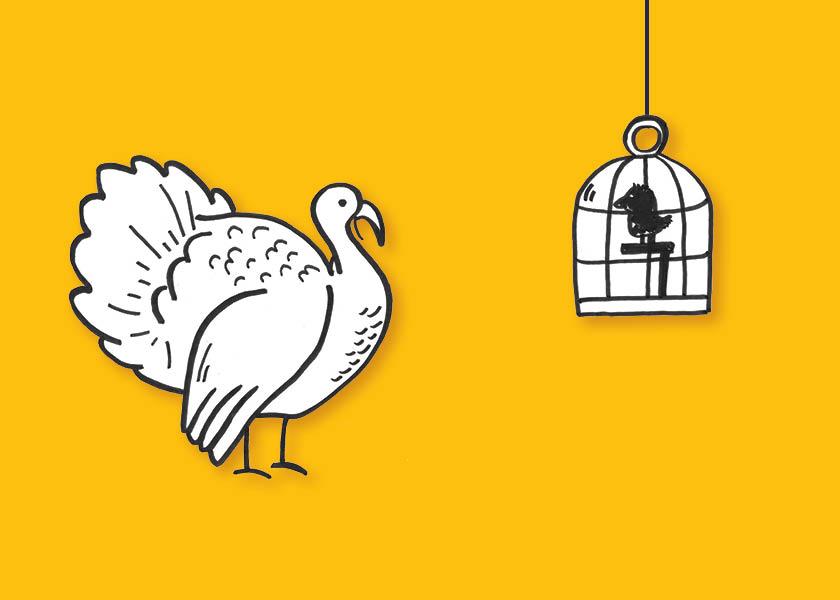Inflation—This Year’s Uninvited Holiday Guest

What do a Thanksgiving turkey and a canary in a coal mine have in common? More than you might think—this year’s turkey has a warning.
Like your oven, inflation is getting red hot. Your 2021 Thanksgiving meal will go in the books as the most expensive in history. American Farm Bureau estimates a meal to cost about 5% more this year.
Inflation did not suddenly sneak up on us, though. This situation has been brewing. High transportation costs and commodity prices, labor shortages and fickle trade policies all add fuel to the inflationary fire. However, some fear one factor could send food prices into the stratosphere and trigger a food crisis.
That tinderbox is fertilizer prices.
Fertilizer’s Effect On Food
The world may face a shortfall in food production as rising energy prices ripple through agriculture, according to Svein Tore Holsether, CEO of Norwegian fertilizer giant Yara International.
“I want to say this loud and clear right now that we risk a very low crop in the next harvest,” Holsether said to Fortune magazine at the recent United Nations COP26 climate conference. “I’m afraid we’re going to have a food crisis.”
Holsether said sharp rises in energy prices have already caused fertilizer prices to nearly triple. Since September, Yara has been curtailing ammonia production by as much as 40%. Other major producers are following suit. Whether you grow Illinois corn or Colombian coffee beans, less fertilizer means higher costs and lower yields.
Holsether’s biggest fear, which others share, is that food inflation has a long tail. He equated the delayed effects of the energy crisis on food security to the silicon chip shortage.
“That’s all linked to factories being shut down in March, April and May of last year, and we’re reaping the consequences of that now,” he said. “But if we get the equivalent to the food system …not having food is not annoying—that’s a matter of life or death.”
We hope the situation is not this dire. Some of us recall 1970s inflation and the cost of fixing it—interest rates greater than 15% and a land price collapse, surging dollar and drop in agricultural exports. No one wants to go back there.
Inflation’s Causes
Blame it on COVID-19, politics or social media, but I see two big similarities between events that triggered the 1970s economic meltdown and today’s politics and economy. First, many say massive governmental spending on Lyndon Johnson’s Great Society initiative and the Vietnam War in the late 1960s ignited inflation in the next decade.
One has to wonder if the stimulus spent to prop up an economy wounded by COVID-19 could see inflation as its lingering side effect. Many in Washington, D.C., want the spending spree to continue on infrastructure and the Biden administration’s Build Back Better plan. The Great Society, Build Back Better—it is all real money that has a cost—no matter the decade.
Rising energy prices are the second similarity. Although we haven’t seen nationwide gas lines on the news, fuel prices are rising rapidly. Oil prices have doubled since November 2020. By Christmas 2021, we may see a barrel at more than $100. Meanwhile, the administration facilitates this outcome by closing major oil pipeline projects and limiting and canceling oil and gas leases on federal land. It is now begging OPEC to pump more oil. There’s a blast from the past.
Higher wages may accelerate a return to an inflation era. We have too few waitresses to take your order, maids to clean your hotel room and drivers to haul products. Before the pandemic, progressives were clamoring for a minimum federal wage of $15 per hour. Now, you can’t get 4-year-olds to clean their rooms for less than that!
What It Means For Ag
For farmers, if corn and fertilizer prices go up simultaneously, then that only makes the stakes higher, and it costs more to play the game. Analysts predict at least 3 million acres to shift from corn to soybeans in 2022. Depending on fertilizer prices, 3 million acres may only be a start, and global commodity supplies could get more out of whack.
If we see an extended period of inflation-driven high food prices, then farmers and consumers should both worry. If the Federal Reserve raises interest rates to combat this inflationary dragon, then things could get really dicey. It may be time to break out the Gerald Ford “Whip Inflation Now” buttons from the ’70s or print new ones!







